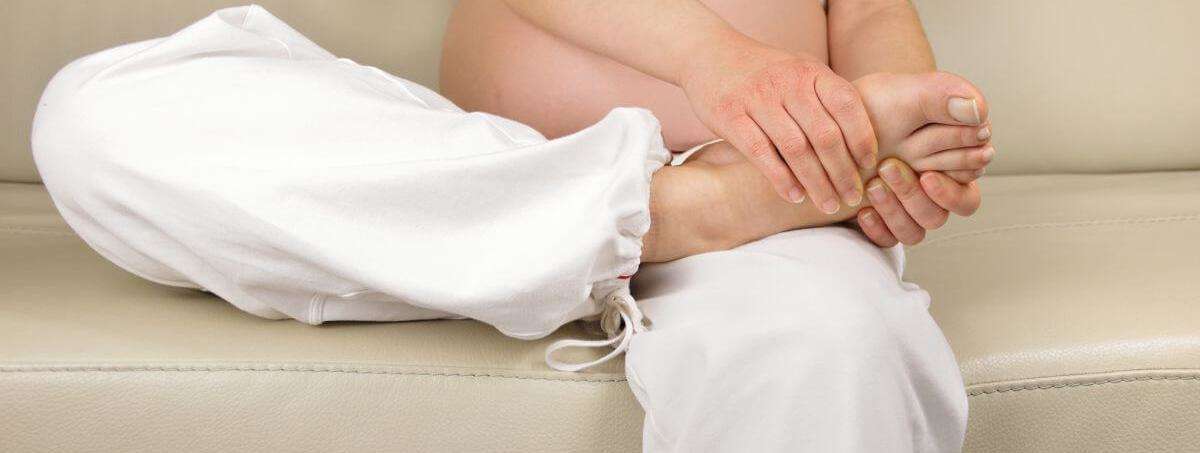The Best Treatments for Swollen Feet During Pregnancy: Effective Solutions for Moms Swollen feet during pregnancy and ankle swelling are common symptoms that many moms-to-be experience, especially in the second and third trimesters. This natural yet uncomfortable condition is primarily caused by increased fluid retention and pressure from the growing uterus on blood vessels, which slows circulation to the lower body.While often harmless, ankle swelling in pregnancy can interfere with daily comfort, mobility, and even sleep. That’s why understanding how to manage and reduce swelling is essential—not just for physical ease but also for overall well-being and peace of mind during this important time.In this guide, we’ll dive into everything you need to know about swollen feet during pregnancy: why it happens, when it’s normal (and when it’s not), and the best ways to soothe and treat it. From practical lifestyle changes and home remedies to expert-recommended products like Inthenso Mom’s Draining Cream, we’ll cover effective solutions to help you feel more comfortable every step of the way. Swollen Feet During Pregnancy – Why It Happens and How to Address It Ankle swelling pregnancy is one of the most common physical changes expecting moms notice, especially in the later stages. This condition, also known as edema, is mainly caused by increased fluid retention, hormonal shifts, and the growing uterus putting pressure on the veins that carry blood back from your lower body.Why It Happens:Fluid retention: Your body produces about 50% more blood and fluids to support the developing baby.Hormonal changes: Hormones like progesterone cause blood vessels to relax, which can lead to fluid pooling in the lower extremities.Uterine pressure: As the uterus expands, it presses against the veins in the pelvis, making it harder for blood to return to the heart.When It Starts:Swelling often begins around the second trimester and may worsen during the third trimester, especially:After standing for long periodsIn hot weatherLate in the dayMost Affected Areas:FeetAnklesLower legsWhen to Worry:Sudden or severe swelling in the hands, face, or feetSwelling in only one leg, accompanied by pain or rednessHeadaches, blurred vision, or dizzinessThese could be signs of pre-eclampsia or deep vein thrombosis (DVT), both of which require immediate medical attention.Understanding the reasons behind ankle swelling during pregnancy can help you stay alert and proactive in managing it safely and effectively. Is Ankle Swelling During Pregnancy Normal? A Complete Guide for Expecting Moms Swollen feet during pregnancy are not only common—they're often considered a normal part of the body’s adjustment to growing a baby. Your body is working overtime to produce more blood and fluids, which naturally leads to some swelling, especially in the feet and ankles.What’s Normal?Most of the time, ankle swelling is completely normal. You might notice:Gradual swelling that worsens throughout the daySwelling that’s symmetrical in both feet or anklesPuffiness that improves after rest or elevating your feetThese signs are usually harmless and are simply the body’s way of adapting to pregnancy changes.Common Swelling Patterns:Worse in the evening due to gravity and long hours on your feetMore noticeable after standing or walking for extended periodsIncreased during hot weather, when blood vessels tend to dilate moreWhat OB-GYNs Say:Most obstetricians agree that mild to moderate swelling—especially late in pregnancy—is expected. They often recommend simple strategies like hydration, rest, and gentle movement to help manage symptoms. However, they stress the importance of paying attention to sudden or uneven swelling.When to Consult Your Healthcare Provider:Sudden or severe swelling, especially in the hands or faceSwelling in only one leg, which could indicate a blood clotAccompanying symptoms like headaches, blurred vision, or abdominal painWhile swollen feet during pregnancy are usually no cause for alarm, knowing what’s typical and when to take action can help ensure a safe and healthy experience for both mom and baby. Skincare Spotlight: Inthenso Mom’s Draining Cream GUAM Inthenso Mom, Anti-swelling Cream for Ankles and Legs For targeted relief, topical treatments like Inthenso Mom, Pregnancy & Postpartum Draining Cream for Legs & Ankles offer more than just surface-level comfort. This pregnancy-safe formula is designed to refresh, tone, and relieve swollen feet and legs while improving skin texture and circulation.How it works: This specialized cream is formulated with natural maternity-safe ingredients to reduce swelling, water retention, and heaviness in the legs and ankles. With regular use, it tones the skin, boosts elasticity, and offers a cooling, soothing effect.Key Active Ingredients:Guam® Marine Algae – Delivers minerals and antioxidants to firm and nourish skinPhytocollagen – A plant-based collagen alternative that hydrates and supports skin structureCaffeine – Promotes circulation and reduces excess fluid buildupDiosmin – Enhances blood vessel function and improves microcirculationEscin (Horse Chestnut Extract) – Eases inflammation and fluid retentionMenthol – Provides an instant cooling sensation and refreshes tired legs Shop Preventing and Reducing Ankle Swelling During Pregnancy: Top Tips Managing ankle swelling pregnancy symptoms doesn’t have to be complicated. With a few mindful adjustments to your daily routine—especially in the areas of lifestyle, diet, and skincare—you can help reduce discomfort and promote better circulation throughout your pregnancy.Lifestyle Changes:Gentle movement and mindful rest go a long way in keeping swelling at bay.Stay active with low-impact exercises like walking, swimming, or prenatal yogaElevate your feet whenever possible to encourage fluid drainageAvoid sitting or standing for long periods—try to change positions oftenSleep on your left side to improve blood flow and reduce pressure on the vena cavaDietary Tips:What you eat plays a vital role in how your body manages fluids.Limit sodium intake to prevent fluid retentionStay hydrated—drinking plenty of water actually helps flush out excess fluidsAdd potassium-rich foods like bananas, spinach, sweet potatoes, and avocados to balance electrolytesFootwear & Clothing:The right gear can relieve pressure and support circulation.Wear comfortable, supportive shoes—avoid heels or narrow fitsSkip tight socks or leggings that constrict blood flowUse compression socks (if recommended) and maternity support bands to provide gentle pressure and supportSkincare: Topical Treatments and MassageSkincare isn’t just about softness—it’s part of your comfort routine.Topical treatments, like Inthenso Mom’s Draining Cream, are specially formulated to help reduce fluid buildup and improve circulation. These creams typically include natural anti-inflammatory ingredients such as caffeine, menthol, or arnica, which help soothe swollen tissues when massaged into the skin.Gentle foot and leg massages using these creams or oils can improve blood flow and reduce tension in your lower limbs.Incorporating these practical strategies can make a noticeable difference in how your body feels—helping you manage ankle swelling pregnancy with confidence and care. How to Soothe Swollen Feet During Pregnancy: Top Tips and the Role of Inthenso Mom’s Draining Cream Dealing with swollen feet during pregnancy is something most expecting moms can relate to. The pressure from your growing baby, increased fluid retention, and hormonal changes all contribute to discomfort, especially in your feet and ankles. If you’re searching for effective ways to ease ankle swelling pregnancy symptoms, a mix of home remedies and targeted skincare can offer real relief.Home Remedies and Self-Care Tips:Foot soaks with Epsom salt: A warm (not hot) soak helps relax muscles and reduce swelling.Cold compresses: Apply a cold cloth or gel pack to swollen areas for 10–15 minutes to reduce puffiness.Foot massages: Gentle upward strokes stimulate circulation and help release trapped fluid.Rest and stretch: Take short walking breaks and perform calf stretches throughout the day to prevent fluid buildup. The Best Treatments for Swollen Feet During Pregnancy: Effective Solutions for Moms Swollen feet during pregnancy can feel like a daily battle—but the good news is, there are several effective and safe treatments that can ease discomfort and restore a sense of lightness to your legs. Whether you're in your second trimester or nearing delivery, managing ankle swelling pregnancy symptoms is possible with a mix of smart lifestyle habits and targeted solutions.Tried-and-True Non-Medical Remedies:Stay active with gentle movement like walking, swimming, or prenatal yogaHydrate regularly to help flush out excess sodiumElevate your feet above heart level when restingTake regular breaks from standing or sitting for long periodsThe Power of Topical TreatmentsAmong all the options, topical creams stand out as one of the most effective and accessible ways to soothe and treat swollen feet and ankles.Why they work so well:They deliver targeted relief directly where you need it mostFormulas often include cooling, anti-inflammatory, and circulation-boosting ingredientsTopicals are non-invasive, fast-acting, and easy to incorporate into your daily routineLook for creams made specifically for pregnancy, like Inthenso Mom’s Draining Cream, which is packed with powerful, maternity-safe ingredients like Guam® Marine Algae, Caffeine, Menthol, and Phytocollagen to reduce swelling, improve circulation, and tone tired legs and feet.Additional Treatment Options:Massage therapy or prenatal reflexology: These help stimulate lymphatic flow and reduce fluid buildupCompression therapy: Wearing compression socks (with your doctor’s guidance) can support veins and reduce swellingNatural remedies: Mild essential oil foot soaks (like lavender or peppermint) and herbal foot bathscan be relaxing—but always consult your OB-GYN first Read next: How to Tighten Loose Skin after Pregnancy: Without Surgery Tailor Your Treatment Every pregnancy is different. The most effective approach combines consistency with personalization—adjust treatments based on your trimester, medical history, and how your body is responding.With the right combination of rest, movement, and topical care, you can manage swollen feet during pregnancy and feel more at ease throughout your journey. When to Seek Medical Attention for Swelling While Swollen Feet During Pregnancy is often a normal part of the journey, it’s important to recognize when swelling may indicate something more serious. Most of the time, ankle swelling during pregnancy is due to fluid retention and pressure from your growing uterus—but there are cases where it can signal an underlying medical issue that needs immediate attention.Watch for These Warning Signs:If you experience any of the following, contact your healthcare provider without delay:Sudden or severe swelling, especially if it comes on quicklyUneven swelling (affecting only one leg or foot)Swelling accompanied by headache, blurred vision, dizziness, or abdominal painPain or tenderness in the swollen area, particularly in the calfShortness of breath or chest discomfortThese symptoms could point to pre-eclampsia, a potentially dangerous pregnancy complication involving high blood pressure and signs of damage to organs such as the liver or kidneys. They may also indicate deep vein thrombosis (DVT), a blood clot that requires urgent care.The Role of Prenatal MonitoringRoutine prenatal appointments play a key role in tracking swelling, blood pressure, and other vital signs. Always bring up changes in your swelling pattern or associated symptoms with your OB-GYN. Preventative Skincare: Why It Matters One of the simplest and most effective ways to stay ahead of ankle swelling pregnancy symptoms is by incorporating topical treatments into your daily routine. Here’s how creams and lotions can help:Boost circulation and support lymphatic drainageProvide instant cooling and soothing relief to tired, heavy legsHelp maintain skin elasticity and firmness, reducing discomfort as swelling progressesPrevent buildup of fluid in ankles and feet when used regularlyChoosing a high-quality, pregnancy-safe cream ensures you're nurturing your body while supporting overall comfort. These creams can be a gentle yet powerful ally in keeping swelling manageable—especially when paired with movement, hydration, and rest. Listening to your body and taking proactive care is the best way to ensure a safe and comfortable pregnancy. Conclusion Swollen Feet During Pregnancy are a common and often harmless part of the journey to motherhood. While it can be uncomfortable, understanding the causes of ankle swelling during pregnancy and knowing how to manage it can make a big difference in your day-to-day comfort. From simple lifestyle changes to effective topical treatments like Inthenso Mom’s Draining Cream, moms-to-be have a variety of gentle, safe options to ease the pressure and feel more at ease.Remember, every pregnancy is unique, and what works for one person might not work for another. Always feel empowered to speak with your healthcare provider if you have concerns or if your swelling seems unusual. With the right tools, awareness, and support, you can stay comfortable, confident, and focused on the joy of preparing for your baby’s arrival. Taking care of yourself—your body, your skin, and your well-being—is not just okay during this time, it's essential. Author of the blog Yana NesterovaYana is the writer behind the Guam Beauty blog who firmly believes in the concept that beauty begins in a person’s head, not in the mirror. Therefore, she strives to encourage her readers, who are beauty and skincare enthusiasts, to bring mindfulness into their skincare rituals by making more conscious choices. Her philosophy is to enable her readers to salvage mental peace and optimal health by living more mindfully and achieving their skin and body goals throughhealthier choices.
Collection 2019
Sale 70% Off
Third slide





